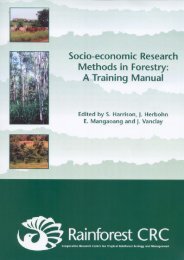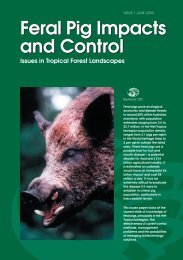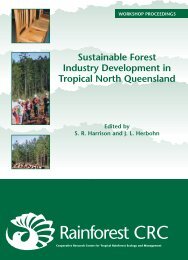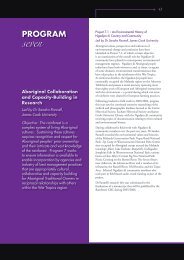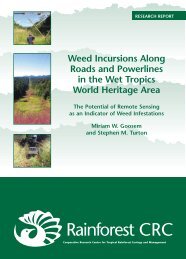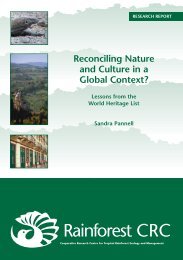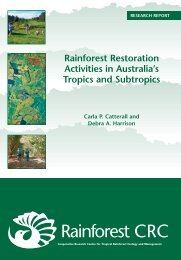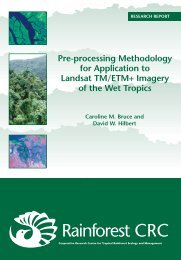Reconciling Nature and Culture in a Global Context? - Rainforest ...
Reconciling Nature and Culture in a Global Context? - Rainforest ...
Reconciling Nature and Culture in a Global Context? - Rainforest ...
Create successful ePaper yourself
Turn your PDF publications into a flip-book with our unique Google optimized e-Paper software.
<strong>Reconcil<strong>in</strong>g</strong> <strong>Nature</strong> <strong>and</strong> <strong>Culture</strong> <strong>in</strong> a <strong>Global</strong> <strong>Context</strong>?Lessons from the World Heritage Listsquare kilometres (PHKA <strong>and</strong> TNC 2000, Vol. 1: 36). The proposed extensions are, <strong>in</strong> part,driven by the IUCN evaluation of the orig<strong>in</strong>al nom<strong>in</strong>ation by the Government of Indonesia,which stated that with “the <strong>in</strong>creas<strong>in</strong>g tourism <strong>and</strong> the s<strong>in</strong>gular focus on the Komododragons” there is a need to “broaden the <strong>in</strong>terest of visitors to other natural attractions(particularly the mar<strong>in</strong>e environment)” (IUCN 1991: 27). Act<strong>in</strong>g upon the IUCNrecommendations, <strong>in</strong> 1995 a ‘rapid ecological assessment’ was undertaken by The <strong>Nature</strong>Conservancy (TNC). This assessment concluded that ‘limited eco-tourism <strong>and</strong> research’ arethe “only true susta<strong>in</strong>able uses” of the terrestrial portions of the Park (PHKA <strong>and</strong> TNC 2000,Vol. 1: 36). As such, the assessment recommended an extension of the Park’s borders to<strong>in</strong>clude mar<strong>in</strong>e areas with high biodiversity values <strong>and</strong> “high aesthetic values” (loc. cit.).Up until the mid 1990s, the “s<strong>in</strong>gular focus of the [P]ark”, <strong>and</strong> that of the previous regulations<strong>and</strong> decrees, was on the “very impressive <strong>and</strong> remarkable animal – Varanus komodoensis”(IUCN 1991: 27). As far as the IUCN were concerned, the challenge fac<strong>in</strong>g the Park <strong>in</strong> thefuture was “to determ<strong>in</strong>e its [the Komodo dragon] particular importance to science <strong>and</strong> toconservation <strong>in</strong> the global context of other isl<strong>and</strong>s” (loc. cit.). As these comments suggests,up until this time the value of the Komodo dragon to the ‘<strong>in</strong>ternational community’ <strong>and</strong> to thegeneral public had largely been that of a scientific curiosity. Through the popularisation ofscientific expeditions to the isl<strong>and</strong> <strong>in</strong> the pages of National Geographic (Burden 1927a;Broughton 1936), various travel accounts (e.g. Schill<strong>in</strong>g 1957; Attenborough 1959), <strong>and</strong> <strong>in</strong>tourist guidebooks (Dalton 1978), the ‘dragons’ have been transformed from evolutionaryoddities <strong>in</strong>to ‘media-genic megafauna’ (Freeman <strong>and</strong> Kreuter 1994). In the words of theIUCN assessors, Komodo dragons are “dramatic or symbolic life forms” (1990: 28). In thefollow<strong>in</strong>g pages I explore how the World Heritage list<strong>in</strong>g of Komodo National Park set <strong>in</strong>motion a reevaluation <strong>and</strong> representation of this dragon-focused view of nature. As I argue,the ‘scientific’ redef<strong>in</strong>ition of ‘nature’ <strong>in</strong> terms of current ideas about biodiversity <strong>and</strong> ‘balance’has serious social <strong>and</strong> cultural implications for the approximately 3,267 <strong>in</strong>dividuals liv<strong>in</strong>gwith<strong>in</strong> the Park <strong>and</strong> for a further 16,816 people liv<strong>in</strong>g <strong>in</strong> villages directly surround<strong>in</strong>g the Park(PHKA <strong>and</strong> TNC 2000, Vol. 1: 5).CULTURE WARS, PART IIn his account of the American Museum of Natural History scientific expedition to Komodo<strong>and</strong> Padar Isl<strong>and</strong>s <strong>in</strong> 1926, the leader of the expedition, W. Douglas Burden, describes theforty residents of the village of Komodo as ‘convicts’ (Figure 8). He goes on to characterisethe villagers as “a degenerate lot of diseased people, that have reached such a degradedstate that they don’t seem capable of curiosity” (1927b: 103). In contrast, Burden valorisesthe “wilderness of romantic Komodo” (Figure 9) <strong>and</strong> concludes, “Komodo is a place ‘whereevery prospect pleases, <strong>and</strong> only man is vile’” (1927b: 103). Burden’s depiction of theKomodo isl<strong>and</strong>ers arguably represents the first shot fired <strong>in</strong> the twentieth century <strong>in</strong> theensu<strong>in</strong>g ‘culture wars’ aimed at vilify<strong>in</strong>g the local population. As I discuss later <strong>in</strong> thischapter, Burden’s dist<strong>in</strong>ction between a ‘vile’ humanity <strong>and</strong> the ‘beautiful scenes’ afforded bynature on Komodo Isl<strong>and</strong> is a trope consistently reproduced <strong>in</strong> the history of this region as aprotected area.While Burden believed that the arrival of his yacht was a historic first for the <strong>in</strong>habitants of theisl<strong>and</strong>, accord<strong>in</strong>g to Auffenberg there were at least four previous scientific expeditions to theisl<strong>and</strong> <strong>in</strong> the period of 1910-1926 (1981: 363). As stated <strong>in</strong> the title of his book, Burden’saccount conjures up the idea of Komodo Isl<strong>and</strong> as a ‘lost world’. Yet, other accounts <strong>in</strong>dicatethat Komodo, <strong>and</strong> the neighbour<strong>in</strong>g isl<strong>and</strong>s of Sumbawa <strong>and</strong> Sumba, were historically caughtup <strong>in</strong> regional geo-politics, <strong>and</strong> from the 1600s were very much <strong>in</strong>volved <strong>in</strong> the mach<strong>in</strong>ationsof Dutch colonisation <strong>in</strong> this part of eastern Indonesia.In an article based primarily upon the l<strong>in</strong>guistic work of the Dutch missionary Father JilisVerheijen on the ‘people <strong>and</strong> language’ of Komodo (1982), the anthropologist, Rodney21




